Is a Trans Am the best alternative to Buick’s GNX?
Want a better understanding of what’s driving collector-car values? Sign up for the Hagerty Insider newsletter.
Can a substitute ever be as satisfying as the real thing? It’s a question with which we all seem to struggle from a young age. It’s not always broccoli versus ice cream, either—often, the comparison is much closer, like Matchbox versus Hot Wheels. Each has its high points, and though you may prefer one, and all the hype tells you that it’s superior, the other just might impress if you give it a chance.
Take the 1987 Buick GNX and the 1989 Pontiac Trans Am 20th Anniversary Edition: they’re the protagonists in what might be the ultimate ’80s domestic-substitution challenge. Since the Black Buick’s prices remain stratospheric, could it be that the best alternative comes from cross-town Pontiac?
We can see the furrowed brows of the Buick faithful through the screen. Yes, you’ve got a point—despite nearly identical drivetrains, the differences between the Buick and the Poncho are black and white, much like the sole color choice offered on each car. Besides, wouldn’t a lesser-trim Regal scratch that GNX itch without the GNX price tag? Buick built thousands of the turbo Regal variants between 1978 and 1987, from the super-niche 1987 Turbo Regal Limited (1035 produced) to the more garden-variety Grand Nationals and T-Types, and they cover a broad price spread, too. But, if you want a range-topping, Ferrari-eating, force-fed piece of ’80s American history, and you like your cars ultra-rare, it’s either the GNX or the ’89 turbo T/A.
This turbo turf war has its roots in 1978, when Buick made quite the pivot. Hailing from the city that forged the formula for the V-8 muscle car, the Regal Sport Coupe’s fancy turbocharged 3.8-liter V-6 debut signaled a new path to power. Sure, its 165 hp and 245 lb-ft of torque did little to evoke the tire-evaporating 455 in Buick’s departed GS, but it was a step in the right direction. (It was also the only turbocharged domestic on the market that year, with Porsche, Saab, and Mercedes-Benz the only others with turbocharged models in the U.S.)
Oldsmobile and Chevy experimented with turbos in the ’60s, but they dropped the comparatively complex, boosted engines from their lineups relatively quickly. Pontiac would add a turbo to the 4.9-liter V-8 in the 1980 and ’81 Trans Am, but of GM’s brands, it was Buick that committed to the technology.
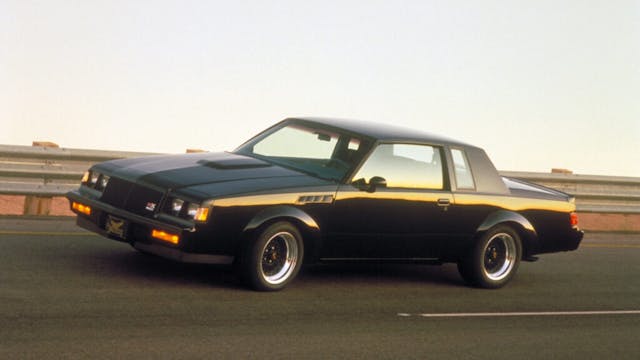
Sticking with forced induction led to increasingly powerful—if outwardly mundane—Buick Regals roaming the streets in the early ’80s. The Grand National nameplate emerged in 1982 as an aesthetic and interior celebratory package for Buick having won the Manufacturer’s Cup in the NASCAR Winston Cup Grand National Series. Available on base-engine Regals or the Regal Sport Coupe with the turbo, the ’82 Grand National was the first step in building the bad-boy visual for Buick’s turbo coupes.
Though you could pick out a Regal T-Type (the turbocharged trim that replaced the Sport Coupe) in a variety of colors, 1984 marked first year of the black-only Grand National, its 200-hp and 300-lb-ft rating, and its TV ads with a Buick-ized version of George Thorogood’s “Bad to the Bone.” People took notice. Buick subsequently made incremental improvements in engine management, intercooling, and ignition to pressurize their variety of turbo Regal trims until the blown Buick crept into into Corvette power territory in 1987 with 245 hp and 355 lb-ft of torque.
By then, word was out. In addition to the turbo Regal’s reputation for speaking softly and cruising with a big stick, 1987 would be the final year for rear-wheel drive Regals. Turbo Buick fans came out in droves to snap up 27,590 units across all trims, or more than three times those sold in 1986.
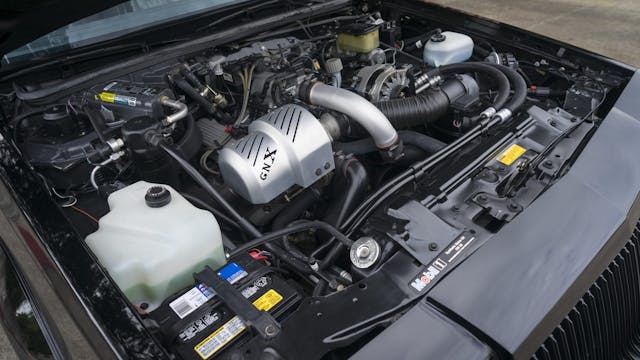
Ahead of this sunset, Buick decided a commemoration was appropriate and got going on the ultimate second-gen Regal—the GNX. It reached out to Automobile Specialty Company (a division of American Sunroof Company, whose initials also spelled ASC) and McLaren Engines (not to be confused with McLaren the automaker) to aid in building a limited run of high-test, blacked-out turbo goodness. One look at a GNX and you know it’s different than the standard GN, though not obviously so—subtle badges, fender vents, and flares surrounding black mesh wheels are the tells.
ASC/McLaren’s effort on the engine was more a thorough massage than a complete working over: Boost increased to 15 psi and flowed through a larger turbo with ceramic turbine wheel, and the computer got a more aggressive tune. A new, large-diameter dual exhaust helped the turbo breathe better while revised intercooler piping offered greater thermal efficiency. The result was an almost certainly underrated 276 horsepower and 360 lb-ft of torque, managed through a 200-4R transmission with a new valve body and put to pavement by a reconfigured rear end featuring an F-body-style torque arm, Panhard bar, and strengthened differential cover.
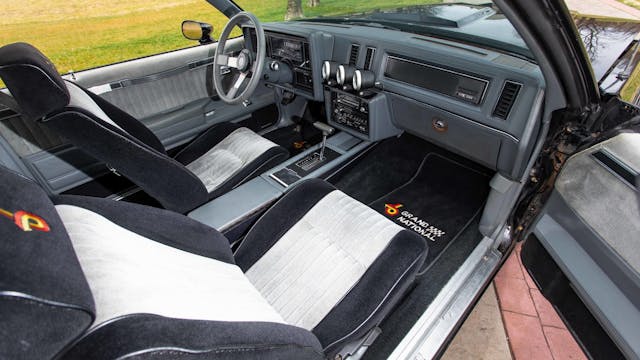
All that power launched the GNX to 60 mph in 4.7 seconds and a then-brutal quarter-mile result of 13.5 seconds at 102 mph in Car & Driver’s testing. On the strip, this was good enough to place Buick’s bruiser at the pointy end of the fastest production cars available. It’s best to keep GNXs on the straight and narrow, though: “Clearly, the engine and the chassis are in separate leagues,” wrote Tony Assenza in the May 1987 issue of Car & Driver. “What we have here is a great powerhouse of a motor looking for a nice place to live.”
That criticism and underwhelming chassis didn’t matter a lick. Enthusiasts knew what these cars were about and loved every inch of them. Buick produced a mere 547 GNXs, and buyers scooped them up in a frenzy, often paying well over the $29,389 MSRP. Between the brawny motor and badass reputation cultivated by the Grand National that preceded it, the top-dog GNX has enjoyed a strong secondary market from the beginning and its legendary status has long been secure.
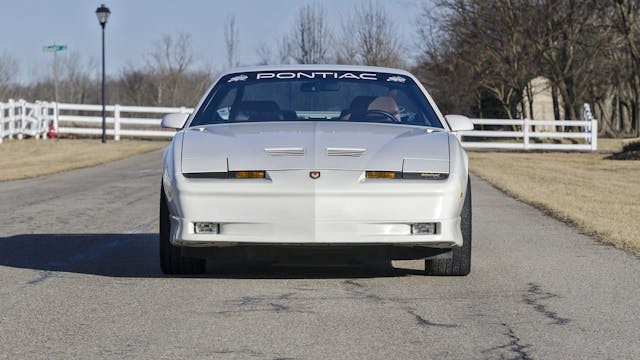
Younger readers might be surprised to learn GM didn’t always have a reputation as a monolithic corporation. For the first 50 years of operation, its many brand divisions operated semi-autonomously, each division utilizing and developing technology that was at times shockingly distinct from that of its corporate compatriots. In other words, Oldsmobile did its own thing, as did Cadillac, Buick, Chevy, GMC, and Pontiac. By the 1980s, GM chairman and CEO Roger Smith’s cost-cutting overhaul ushered in extensive tech trade and sharing between the GM siblings, but there was still significant internal competition.
So, while Pontiac was probably sick of its halo, 305-cubic inch, tuned-port injection Trans Ams losing drag races to Buick’s personal luxury coupes, it wasn’t above harnessing a bit of Buick’s turbo magic to remedy the situation. Pontiac decided to inject the turbo V-6 into the 20th Anniversary Trans Am, and started the project with its top-trim GTA model and all the WS6 handling upgrades.
Unique shocks and shorter front springs were swapped in to match the engine’s lighter-than-small-block weight, and larger brakes from the race-oriented 1LE package found their way behind the front wheels. A T-top roof configuration was an option, as were leather seating surfaces—though tan was the only interior color. Most turbo T/As came fully optioned with leather and the removable roof; finding a cloth interior or a hardtop is a challenge, much less finding one with both. Since the car paced the Indy 500 that year, pace-car door decals were included and installed by the dealer at the buyer’s discretion.
Despite a smaller footprint than the third-gen Firebird’s existing 305-cubic-inch V-8, the 3.8-liter six presented a fitment challenge. The Firebird’s strut towers made for a less accommodating bay than the larger Buick’s, so Pontiac swapped in compact cylinder heads from the 3800-series engine and selected shorter pistons to achieve its desired 8.0:1 compression ratio. Like Buick, Pontiac outsourced these tweaks, using Performance Automotive Systems to build the engines and complete final assembly.
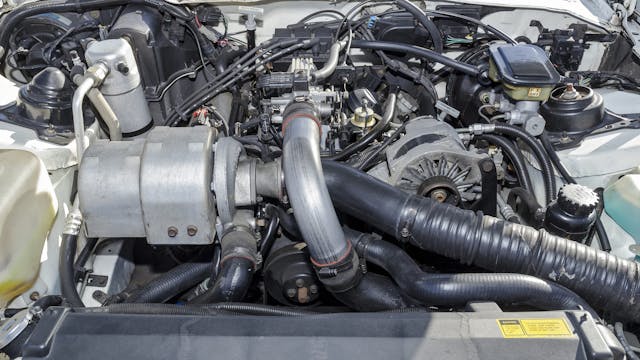
The remainder of the engine components were a mix and match of existing Buick parts and Pontiac-specific selections, yielding 250 horsepower and 340 lb-ft of torque—figures that, like the GNX, are considered substantially underrated. Despite being down 26 horses on paper against the GNX, Car & Driver reported that the turbo T/A was a tenth quicker both to 60 mph and through the quarter mile. Pontiac had bragging rights on a technicality—these straight-line numbers are effectively a dead heat, and it was anyone’s bet at a Woodward Avenue stoplight.
Fulfilling C&D’s wishes, the T/A’s chassis was a better fit for the Buick V-6’s prodigious power. The F-body exhibited greater balance and grip, and was overall a more complete performance package, if a bit less comfortable on the boulevard.
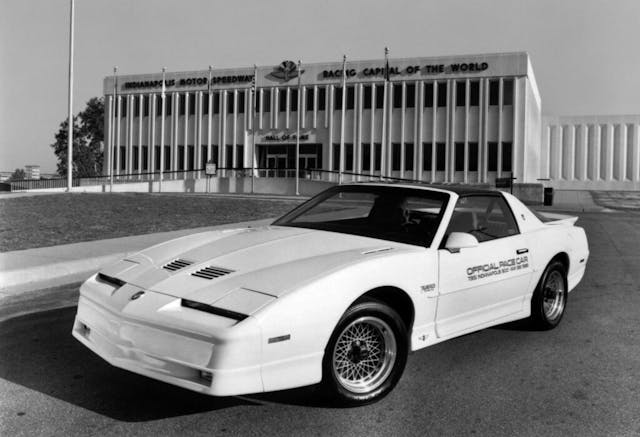
Sources put production at around 1550 turbo Trans Ams—still a very limited run, but nearly three times the amount of GNXs that reached showrooms. While it briefly stood at the top of the heap of domestic performance, it never gained the cult following that the GNX had. Add in the 20th Anniversary Trans Am’s lack of visual differentiation from the lesser Trans Am GTA, and you’ve got the proper mix to make it less valuable to collectors—and simultaneously an opportunity for those who want a usable, affordable classic.
As with many Radwood-era rarities, pristine examples of both cars have increased significantly in value, though the Buick stands head and shoulders above the Pontiac. Ten GNXs have sold on Bring a Trailer for $200,000 or more, and that’s not just from the hot heyday of the pandemic market—the first one on BaT to cross that mark did so in 2019.
Granted, these are almost exclusively museum pieces with minimal mileage and delivery plastic covering the seats, but they slot neatly in between the Hagerty Price Guide‘s #1 condition value of $288,000 and condition #2 (Excellent) $179,000 value. Even driver-quality, #4 condition GNXs sit at the $80,000 mark. Values have softened ever so slightly for all but the top-tier—prices peaked in July last year and have remained stable at slightly lower levels since then.
About 70 percent of quotes for the GNX come from Gen X, which is nearly double that generation’s share from three years ago. Boomers have seen their share of quotes taper to about 20 percent. Millennials are becoming more interested in the GNX, but their share is still only about 5 percent. Insured demographic shares are similar: Gen X leads with 59 percent, 26 percent are owned by boomers, seven percent are owned by millennials, and eight percent by pre-boomers.
In contrast, you could take home four (!) #1-condition turbo T/As for the price of a single #1-condition GNX, or one pristine example for less than a driver-quality GNX. Across all conditions, the Pontiac’s prices continued to rise for one quarter longer than the Buick’s. Unlike the GNX, which throttled back its values slightly before leveling off at the end of the year, the turbo T/A has held steady as the market has begun to cool. This lag and hold does suggest the possibility for a substitution effect, or at least for greater market recognition.
The T/A finds itself sought after by the two dominant generations in the market: boomers and Gen X. It’s not particularly surprising for a rare, niche model to appeal most to those who were alive when it debuted. Together, the two generations almost evenly split nearly 90 percent of the quotes sought for the turbo T/A. Millennial interest is slight. Policies indicate that Gen X owns 52 percent of the turbo Trans Ams insured with Hagerty, with boomers coming in at 38 percent. Millennials have a two percent share, and pre-boomers make up an eight percent share. The average insured value of ’89 turbo T/As is a staggering 4.8 times less than that of the GNX.
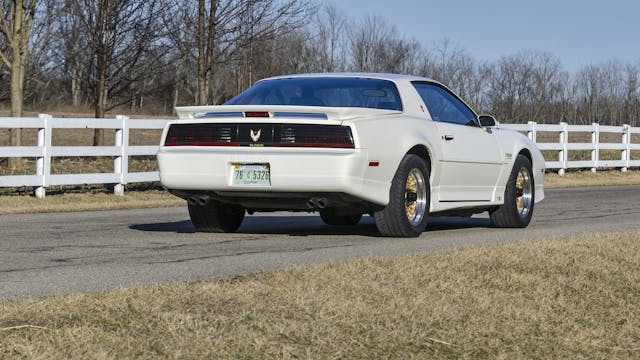
What does this massive delta in values come down to? Mythology and sinister looks that are the last gasp of the muscle-car-era silhouette—the big, bad Buick has those in spades, and they certainly help its appeal. Three-figure production numbers don’t hurt the GNX’s desirability, either. As for the Trans Am, it might be handsome but it’s not nearly as mean, and aside from some badging, it looks identical to its V-8-powered GTA-trim sibling. The pace car decals that adorn many of the cars are an acquired taste as well.
Still, there’s something to be said for the GNX’s affordable cousin. On today’s SUV-filled roads, it’s hard not to be drawn to the ’80s white-on-gold wedge that is the turbo T/A. It might not intimidate the way the GNX does, but its looks are similarly representative of its era. Between the two, the turbo T/A is objectively the better all-rounder, even if the GNX gets the win for comfort and has a stronger following. While few are likely to pursue a top-flight 20th Anniversary Trans Am Turbo over a concours GNX as an investment, for those who drive their collector cars and take pride in owning a rare ride, the turbo T/A scratches that ’80s GM turbo-dominance itch well.
***
Check out the Hagerty Media homepage so you don’t miss a single story, or better yet, bookmark it. To get our best stories delivered right to your inbox, subscribe to our newsletters.
Via Hagerty Insider
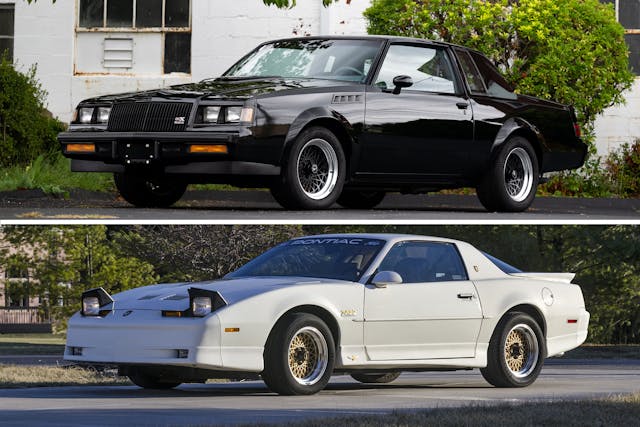


Yes as it made them both better. The engine had a worthy body and chassis and the chassis had a lighter more powerful engine.
This has long been a very underrated car and under valued.
Agreed- better handling, better aftermarket support (both Firebird and Camaro) and better aerodynamics- but missing the “Wow” factor and Darth Vader car look-a-like award.
How well I know about underrated & under valued. Bought my 89 Pace Car new & currently has just 3100 miles. Only take it out to Cars & Coffee events because it’s still wearing the Gatorbacks that it came with. I traded in an 87 GN with only 12K miles on it. It never fit me well & never got over 20 MPG. The TTA on one trip got an impressive 36 MPG. Impressive package all around. I’m thinking of selling it if anyone’s interested.
Who cares about MPG on a Grand National?????
Some people had a GN as a daily driver, which means both city driving as well as a highway weekend trip cruiser. I can see where that would be a big difference. The Firebird of course would get better mileage due to lower rear end gearing than the GN as well as having much lower coefficient of drag. But I doubt his 35mpg claim because I had an ’87 GTA, the exact same aero shape with a 5.7l L98. On the best of road trip I’d get 27mpg.
I would be interested in your 89 Pace Car. Where is the car located? What is you asking price? I am looking at one in Harford . Thanks, Ken
89 tta is one of my favorites . Preference you’d be the coupe . Maybe get one in my next lifetime. Love them Pontiacs had them my whole life can’t beat the performance.
As always, could not agree more. Could never understand the, relatively, ‘soft’ market on the TTA vs the GN, but decided to keep mine (#27, Festival Car), and continue to enjoy…
Two different flavors of ice cream here to me. You might like both, want both, even afford both but they don’t do the same things.
If you can’t afford to buy a real GNX and use it… hot rodding any second gen G-Body to the GNX specs (or better) is the affordable road to do that.
If you like Firebirds, then do that.
I always found the GNX a bit over priced.
It was just a Regal GN with just a little more. Handling is not off the chart, the power today is not that big of a deal and many bought them and stored them so low Mike ones are not difficult to find.
The Trans Am was just a flat better car with this combo and add to it it was a Indy pace car they did not make a gazillion of.
Many were not put away.
Same on the Syclone as it was the best of the 80’s but todays cars just over shadow the 80’s stuff.
The ZR1 back then was over shadowed by the next Gen small block. Yes cool to look at but not the best package for very long.
I appreciate these cars but they to me were just interesting stops to even better cars later on.
The GNX added some tweaks owners would evolve in due course, but added ‘F Car style rear torque arm…’ and PW7 wheels off the WS6/GTA spec sheet, to mimic the TA’s improvements…
Syclone, Typhoon, even the 4.3 Sonoma’s were ‘hot’…
Is the Trans Am a better alternative than a Grand National?
Yes. It has a better interior, much improved suspension and great sightlines when driving.
Just like the 1990-95 Corvette ZR-1 was better in every way from the 1997-2004 C5 Corvette, (bullet proof and very high tolerance machining standards drive train, great interior and seats, higher top speed) the 1989 Trans Am was a generation ahead of the Grand National.
As the previous owner of three 3rd gens birds (87 Formula 350, 89 gta, 91 v6) I obviously would’ve loved a Turbo Trans Am, I always wondered why they looked almost EXACTLY like a regular 89 gta with the only ques from the rear being the turbo in the middle taillight piece and maybe the exhaust. Although now looking back on it I do applaud them for making the car almost a “sleeper” gta? I never was that big a fan of the white/gold color scheme. I think black/gold would’ve been much better imo.
As the current owner of 3 Gen 3’s; an ’84 L69, ’87 LB9 GTA 5spd, and ’89 TTA, all of them white, I can say they are all very different versions of the same great base car. The first two are Firehawk Racecars, the TTA, bone stock, except for the ‘Festival’ PROM (aka, FBI chip)…
I love both but would give the edge to the Turbo Trans Am due to better availability. I would not say no to either of these.
Arguing over what are the coolest cars from the most uncool era in American car making just doesn’t do it for me.
Amen
Uncool?’! You obviously have never driven a GN (and for sure not an X) because if you did and found yourself anywhere near a gas station, restaurant, store, etc you would realize quickly that you are driving one of the coolest cars on the planet by thx crowds of attention these cars attract!
The discourse is about a particular pair of cars that share certain traits, but took different paths to their respective showrooms, and in so doing, breathed a healthy dose of ‘Cool’ into an otherwise very saccharine era…
You’re Welcome…
Well, these two are certainly cool cars, no matter what you may think of their era.
Well I would be quite biased here as I have 2 1975 Trans Ams, custom auto and a stick with a 455 heart transplant. But I will say I would like both! GNX a little overpriced and the T/A would handle better, but I will go for both!
I worked directly at Buick in the inner cooled turbo years, that was when the Buick HQ was in Flint Mi. I also was aware of all the work it took to get the turbo 3.8 in the TA. The list is way more than this article go into. Bottom line the TA was a far better car performance car than the GNX. Why isn’t it an off the chart value? Same reason right now an IROC is worth way more than the same year TA or C4. Image is everthing.
I’d take the Trans Am in a heartbeat IF, I could find one without T tops!
Best guess is there might be 15; that said, see if you can find the Red One…
I’d take either, but the T/A is the better car. Also the largest, most powerful engine available in the T/A prior to the TTA, was the L98 350, not the 305.
Yes, there is something about that jet black Buick that the Firebird is missing. As good as that Trans Am is, the turbo Buick still has the stuff.
My 1984 Saab 900T (turbo) four-door sedan cruised through Montana non-stop at 180 km/h with a full load of luggage and four people, and it did not need to slow down much through the twisties up and over the Rockies. Neither of these GM turbos could do either of those things with any grace or reliability. Or maybe even at all. Making them fetishes more than cars. But then, I never understood the appeal of straight-line street monsters. YMMV!
If you think a WS6 suspension Trans AM is just a straight line monster, then you haven’t been paying attention. Sorry, but it will run rings around a Saab.
Not familiar with the WS6 performance package option of the T/A are you? It was similar to that of the IROC-Z over the standard Z28 suspension of 3rd gen F-bodies. I’ve had three 3rd Gens (’84 Z28, ’87 Trans Am, ’89 Trans Am GTA). Each would run rings around your Saab on the skidpad, let alone a track.
With all due respect to our Swedish Cousin, my TTA was my daily driver for many years, and was never bothered by ‘twisties’ on Interstates, 2-lane mountain passes, The Streets of San Francisco, or Track Days at Sonoma. Nor to overnight runs to L.A. and back, getting 28mpg on Cruise. With 4 people and luggage, that 900T must be a total Chick Magnet!
Please, no more ‘Saab Stories…’
Volvo, maybe? ;<)
Buick Too played with Turbos in the 1960’s. They were going to twin turbo a Big Block, apparently it put out 700hp but they stopped development because they had a problem of it twisting off the input shaft of the transmission. Also the Turbo Trans Am was the first car to ever pace the Indy 500 without modification, they were all bone stock configuration.
From articles that I have from 1986, the Corvette Indy Pace did not require any engine modifications as well. I think they only have to accelerate to 110-115mph.
True, That!
I was faced with a similar set of choices about 20 years ago. My father wanted a GN and asked me to find one for him. I was tempted to convince him how much better the Turbo TA would be as a sports car, but the mystique of that all black Darth Vader GN would not be denied. He enjoyed the GN for about 5 years and then sold it for a C5 Vette. I can’t help to think if we got the TA, he might have kept it. When its my turn, I know what I’ll choose.